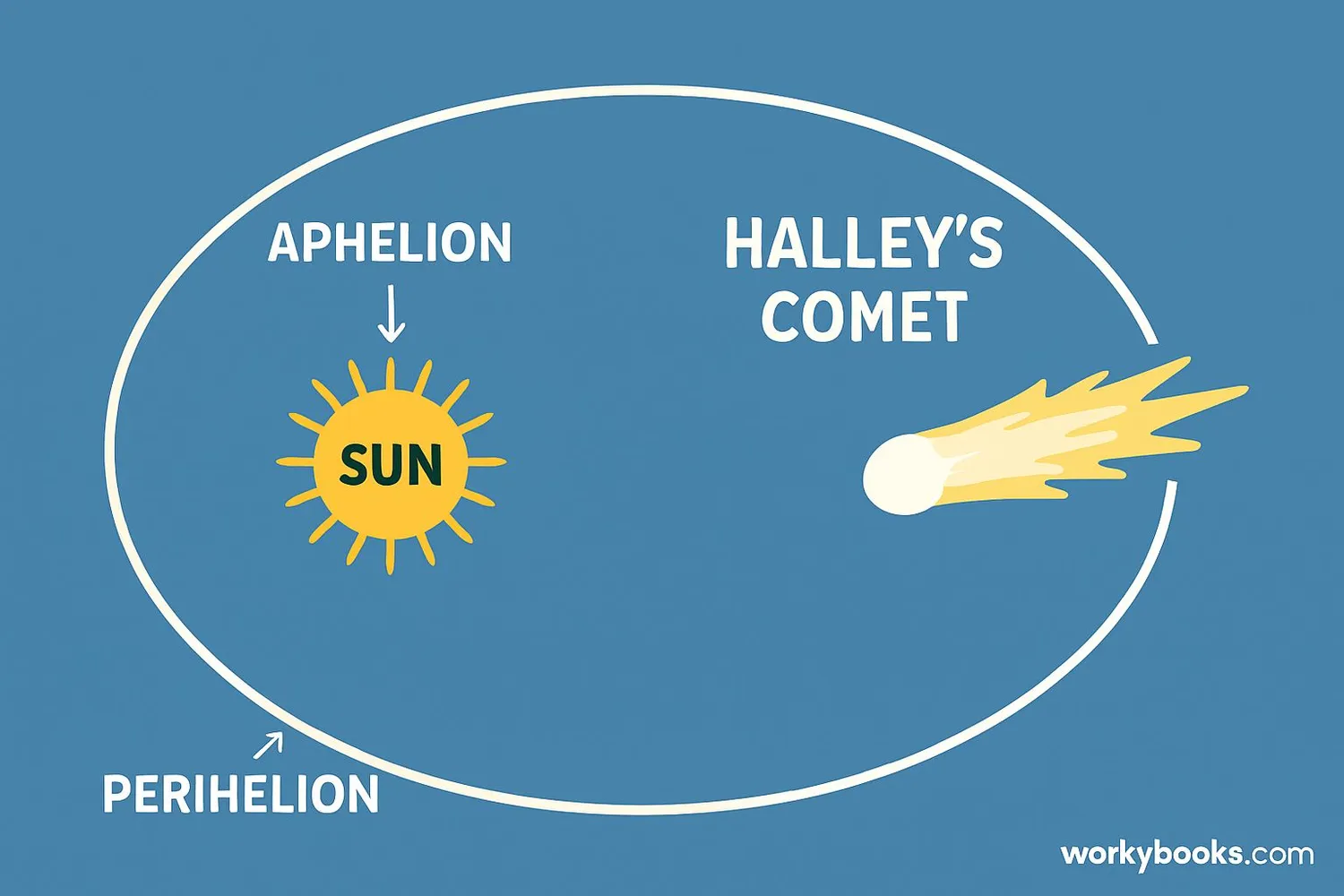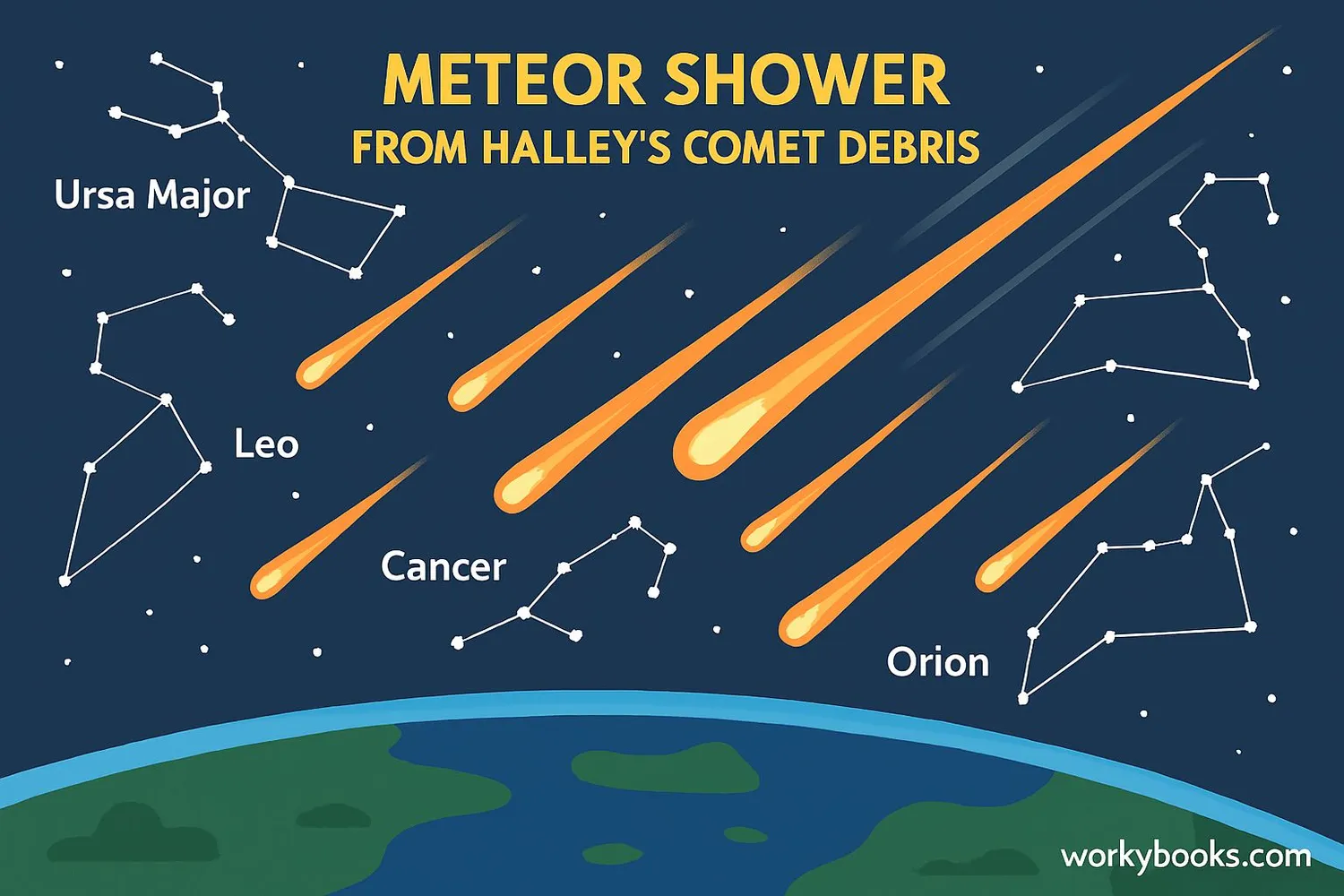Halley's Comet - Definition, Examples, Quiz, FAQ, Trivia
Discover the most famous comet in our solar system - its history, orbit, and when it will return!
What is Halley's Comet?

Halley's Comet is the most famous comet in our solar system. A comet is like a giant "dirty snowball" made of ice, dust, and rock that orbits the Sun. Halley's Comet, officially known as 1P/Halley, is special because it's visible from Earth every 75-79 years.
When Halley's Comet approaches the Sun, heat causes its icy surface to turn into gas, creating a glowing head called a coma and two spectacular tails - one made of dust (which reflects sunlight) and one made of gas (which glows). The tails always point away from the Sun due to the solar wind.
Comet Fact!
Halley's Comet is about 9 miles (15 km) long and 5 miles (8 km) wide - that's about the size of a small town!
History of Halley's Comet

Halley's Comet has been observed for thousands of years! The earliest recorded sighting was by Chinese astronomers in 239 BCE. One of the most famous historical appearances was in 1066 when it was depicted on the Bayeux Tapestry showing the Norman conquest of England.
The comet is named after Edmond Halley, an English scientist who studied reports of comets appearing in 1531, 1607, and 1682. He realized these were actually the same comet returning periodically. Halley predicted it would return in 1758, and though he died before seeing it, his prediction was correct!
239 BCE
First recorded sighting by Chinese astronomers
1066 CE
Depicted in the Bayeux Tapestry
1705
Edmond Halley predicts its return
1910
First photographed appearance
1986
Most recent Earth approach
Orbit and Return

Halley's Comet follows a long, elliptical orbit around the Sun. It takes about 75-79 years to complete one orbit. This makes it a short-period comet and the prototype for a class of comets called Halley-type comets.
The comet travels from just beyond Venus (at its closest to the Sun) all the way out beyond Neptune (at its farthest point). Its next predicted return is in 2061.
When is Halley's Comet next visible? You'll have to wait until mid-2061! But you don't have to wait that long to see evidence of Halley's Comet - it leaves behind debris that causes meteor showers every year.
Speed Record!
Halley's Comet travels at speeds up to 157,838 mph (254,016 km/h) when closest to the Sun - that's 60 times faster than a bullet!
Meteor Showers

Even when we can't see the comet itself, we can enjoy pieces of Halley's Comet every year! As the comet travels, it leaves behind a trail of dust and debris. When Earth passes through these trails, the particles enter our atmosphere and burn up, creating meteor showers.
Halley's Comet is responsible for two annual meteor showers:
Eta Aquarids
Active: April 19 - May 28
Peak: Around May 5-6
Best seen: Southern Hemisphere
Orionids
Active: October 2 - November 7
Peak: Around October 21-22
Best seen: Worldwide
These meteor showers are named after the constellations from which they appear to originate (Aquarius and Orion). Under ideal conditions, you might see 20-30 meteors per hour during peak times!
Halley's Comet Quiz
Test your knowledge about Halley's Comet with this quiz! Answer all 5 questions to see how much you've learned.
Frequently Asked Questions
Here are answers to some common questions about Halley's Comet:
Fun Halley's Comet Trivia
Discover some amazing facts about Halley's Comet!
Speed Demon
Halley's Comet travels at incredible speeds! When closest to the Sun (perihelion), it moves at about 157,838 mph (254,016 km/h) - that's about 60 times faster than a bullet fired from a rifle!
Ancient Observer
The earliest recorded sighting of Halley's Comet was by Chinese astronomers in 239 BCE. This makes it one of the most consistently observed astronomical phenomena in human history.
Spacecraft Visitor
In 1986, five spacecraft from the USSR, Japan, and Europe visited Halley's Comet. The European Space Agency's Giotto spacecraft got closest, flying within 370 miles (596 km) of the nucleus.
Comet Composition
Halley's nucleus is very dark - blacker than coal! It's made of water ice (80%), frozen carbon monoxide, carbon dioxide, methane, ammonia, and dust particles containing silicates and organic compounds.


